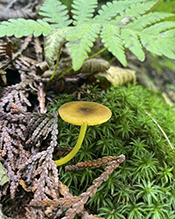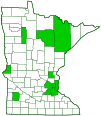Goldleaf Shield
(Pluteus romellii)
Conservation • Description • Habitat • Ecology • Distribution • Taxonomy
Conservation Status |
|
|||||||
| IUCN Red List | not listed |
|||||||
| NatureServe | NNR - Unranked |
|||||||
| Minnesota | not listed |
|||||||
Description |
||
Goldleaf Shield is a small, easily identified, gilled mushroom. It occurs in Europe, Asia, and North America. It occurs across the United States. It is fairly common east of the Great Plains and west of the Rocky Mountains. It is not common in Minnesota. It is found in summer and fall, usually alone, sometimes in pairs, in deciduous and mixed forests, and on wood chips in urban areas. It grows on well-rotted logs, branches, and debris of hardwoods, especially oaks. It obtains its nutrients from dead wood (saprobic). When it first appears, the cap is convex and dark brown to olive-brown to yellowish-brown, usually darker in the center. The upper surface is dry, without hairs or scales (bald), and sometimes wrinkled in the center. Mature caps are fragile, ⅝″to 2″ (1.5 to 5.0 cm), broadly convex or flat, often with a raised bump in the center (umbonate). The cap is obscurely lined toward the margins, and the margins are curved downward or flat. The gills are closely spaced or crowded and are not attached to the stalk (free). They are white at first, turning pinkish as the spores mature. Between the primary gills there are short, secondary gills originating at the margin. The stalk is fragile, straight or curved, ¾″ to 2¾″ (2 to 7 cm) long, and 1⁄16″ to ¼″ (2 to 6 mm) thick, more or less the same thickness from top to bottom. It is pale yellow or greenish-yellow and is usually lighter near the base. The flesh is thin and translucent white or yellowish. It is edible but too small and infrequent to be worth gathering. The spore print is pink. |
||
Similar Species |
||
Habitat and Hosts |
||
Hardwoods, especially oaks |
||
Ecology |
||
Season |
||
Summer and fall |
||
Distribution |
||||
|
Sources |
|||
| 2/25/2023 | ||||
Occurrence |
||||
|
||||
Taxonomy |
|||
| Kingdom | Fungi (fungi) | ||
| Subkingdom | Dikarya | ||
| Phylum | Basidiomycota (club fungi) | ||
| Subphylum | Agaricomycotina (jelly fungi, yeasts, and mushrooms) | ||
| Class | Agaricomycetes (mushrooms, bracket fungi, puffballs, and allies) | ||
| Subclass | Agaricomycetidae | ||
| Order | Agaricales (common gilled mushrooms and allies) | ||
| Suborder | Pluteineae | ||
| Family | Pluteaceae | ||
| Genus | Pluteus (deer mushrooms) | ||
A recently published morphological and molecular analyses of the Pluteus romellii clade (Ševčíková, et al., 2022) showed that the species Pluteus romellii is restricted to Europe and Asia. Five new species are proposed, among them Pluteus austrofulvus and Pluteus parvisporus in eastern North America, and Pluteus vellingae across North America. |
|||
Synonyms |
|||
Agaricus nanus var. lutescens Agaricus romellii Pluteus lutescens Pluteus nanus ssp. lutescens Pluteus nanus var. lutescens Pluteus splendidus |
|||
Common Names |
|||
Goldleaf Shield Yellow-stem Pluteus Yellow-stemmed Pluteus |
|||
Glossary
Saprobic
A term often used for saprotrophic fungi. Referring to fungi that obtain their nutrients from decayed organic matter.
Umbonate
On mushrooms, having a distinct, raised, knob-like projection in the center of the cap.
Visitor Photos |
|||||
Share your photo of this fungus. |
|||||
| This button not working for you? Simply email us at info@MinnesotaSeasons.com. Attach one or more photos and, if you like, a caption. |
|||||
Honey Fae (Farah) |
|||||
 |
|||||
MinnesotaSeasons.com Photos |
|||||
|
|||||

Slideshows |
||

Visitor Videos |
|||
Share your video of this fungus. |
|||
| This button not working for you? Simply email us at info@MinnesotaSeasons.com. Attach a video, a YouTube link, or a cloud storage link. |
|||
Other Videos |
|||
| Plutée de Romell (Pluteus romellii) 100% NATURE |
|||
About
May 28, 2021 Pluteus romellii, la Plutée de Romell, un champignon printanier qui pousse sur débris ligneux. |
|||

Created: 2/25/2023
Last Updated:


